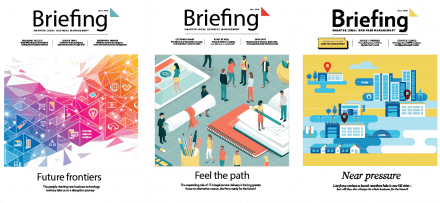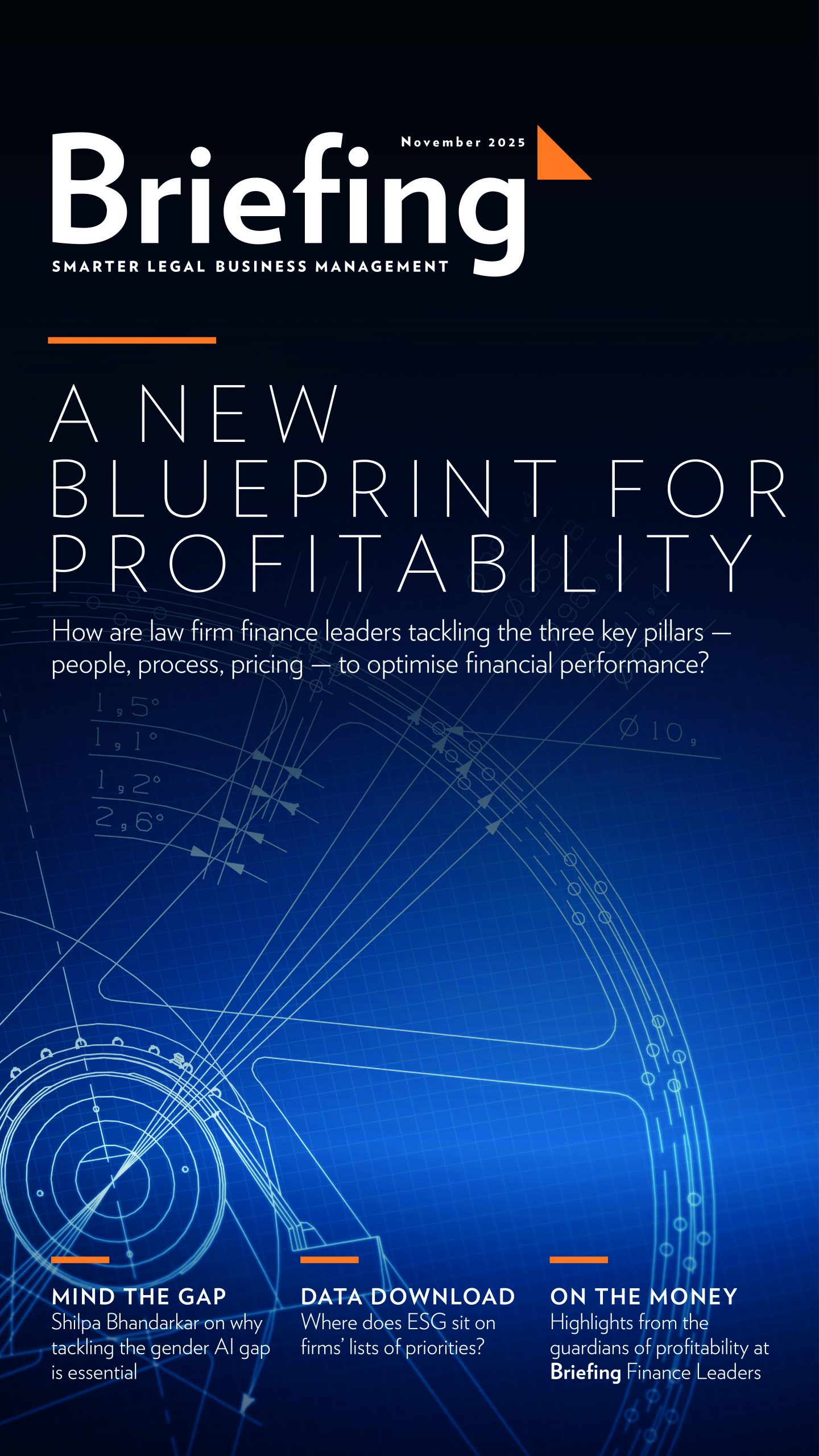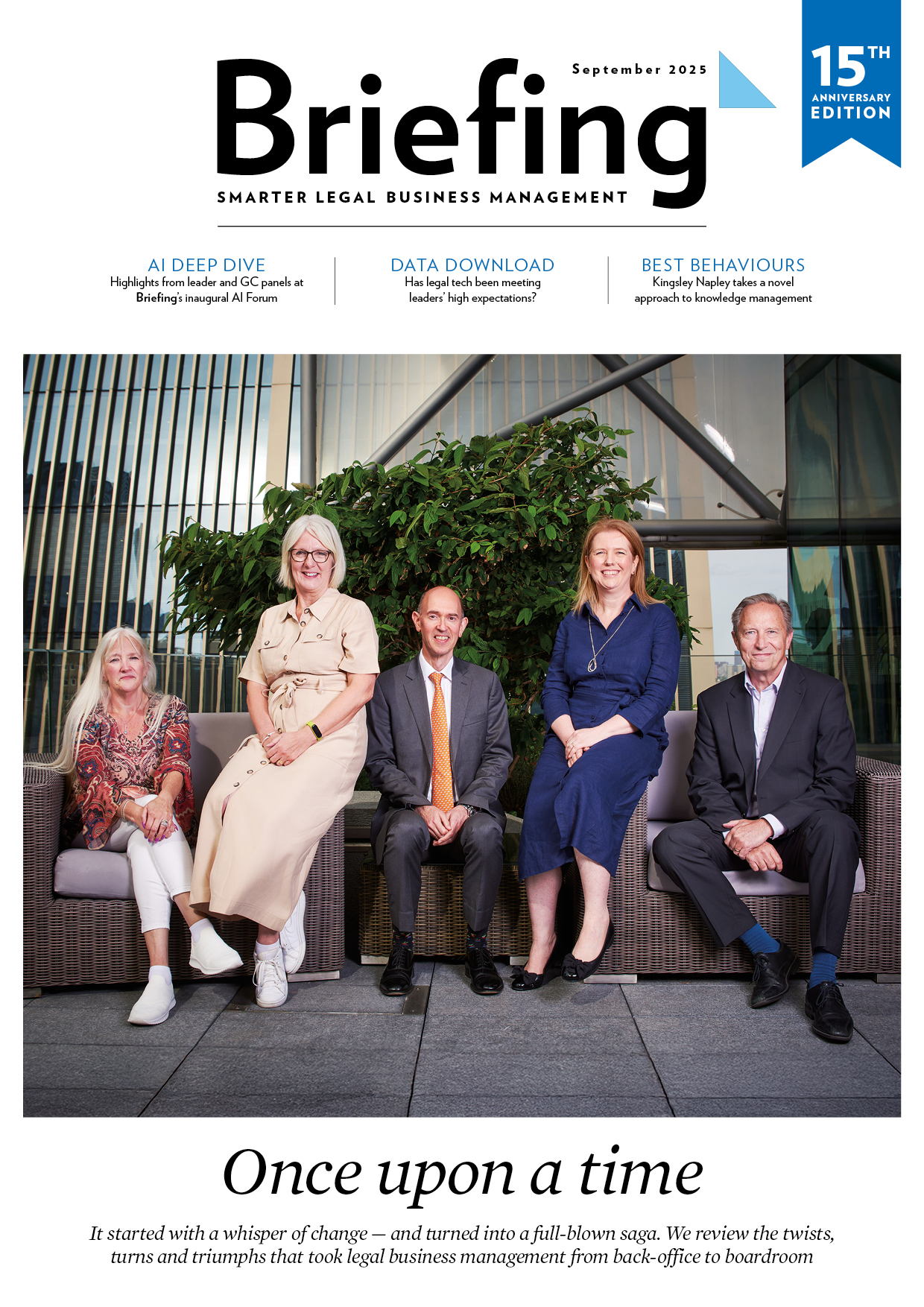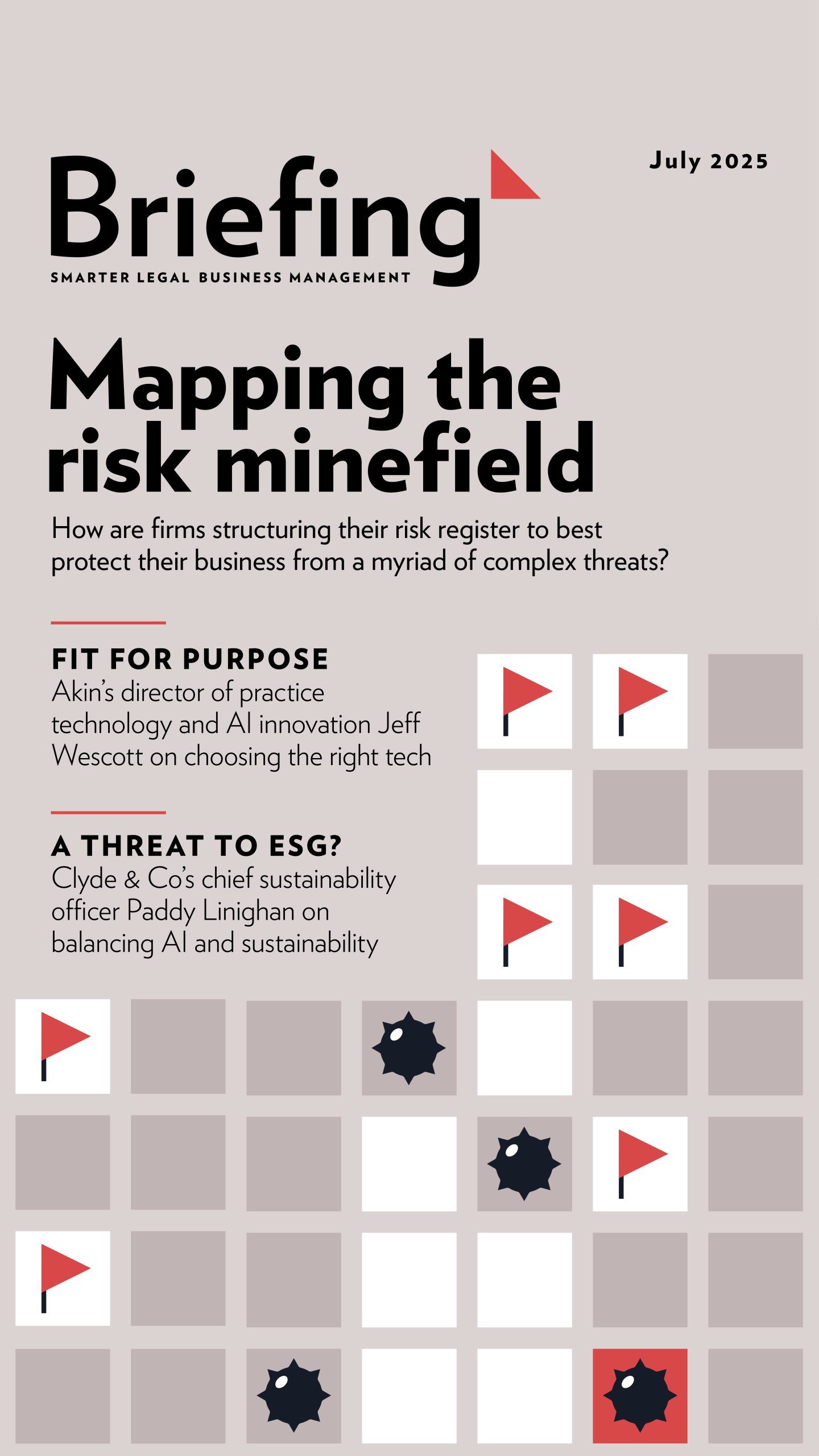
there’s work in process for AI promise to flourish in finance
The annual Briefing/HSBC UK law firm strategy and investment research, which we published in early October 2024, found that almost one in 10 (8%) of C-suite law firm strategic leaders don’t expect their place to be using generative artificial intelligence (genAI) at all heading into 2025.
Even a minority like this saying so came as rather a surprise to us — particularly given 57% at firms across the annual-revenue bandings (starting at approx £18m up) anticipate this technology being harnessed in some way to produce their work for clients at some point within the next 12 months. The ‘not here, not yet’ response was, admittedly, a bit more likely to come from somebody in one of the smaller firms in the sample — where the idea of a ‘race to be second’ seems to be a thing — but they certainly weren’t the only sceptics out there (or perhaps, to be fair, the more cautious/wary of the cost before business models have been adapted accordingly).
The top perceived obstacles to going any further, faster, with genAI, did indeed centre on the impact on risk and resource — accuracy/quality concerns (51%), the bandwidth for exploration/testing out the use cases and dependencies (34%) and security concerns (29%).
And, in addition to supporting with more efficient legal research and workflows — and the creation/delivery of the work itself — the areas where most leaders expected the firm to be making use in some form were knowledge management (73%) and marketing/business development (64%).
By contrast, just over a third anticipated the world of their law firm finance function being impacted before summer 2025.
Build the business services case
This reactivated my thinking about one of our regular Briefing supper club roundtables that took place just a couple of months ago, which welcomed several law firm leaders from HFW, Kennedys, DMH Stallard, Bates Wells, Freeths, Harbottle & Lewis, Shakespeare Martineau, Weil Gotshal & Manges, and Boodle Hatfield (co-hosted with welcome input from experts working for Fulcrum GT).
A conversation by no means limited to navigating the AI risk/reward maze, one point raised was that firms might benefit from starting “smaller” with AI to build up appreciation of the business case — and one such win identified was the far from minor matter of accelerating time to payment (indeed, it’s safe to say a pretty major challenge, according to that Briefing/HSBC UK research this year). Another was onboarding clients more effectively — that is to say, accurately — with less scope for human error creep into the process.
There was a decidedly upbeat sense at the table of genAI moving forward as a likely transformer, not only of business services/back-room efficiency, but also this professional support’s standing as a true driving force of positive progress — continuous process improvement.
Foundation of process or face the fragmentation?
But there’s another side to this coin — for all that the fresh enthusiasm to bring AI into play here has helped to open lots of other conversations across firms about opportunities with (often existing, potentially overlooked) technology, there’s another type of conversation coming up more regularly too. What must firms really commit to changing/fixing in their respective setups first? Perhaps billing ‘simply’ needs centralising before pushing the process further — certainly, the matter of achieving more process consistency was something several raised as a significant issue. Without starting there, rather than the choice of tech/tool, your risk is witnessing a proliferation (to put it politely) of ‘mini’ process flows around each introduction and an unsatisfactorily fragmented overall experience.
Just look at some of firms’ other top challenges at the table to see where this could go — some have grown, even organically, very rapidly indeed; with sprawling divisions, reporting and service lines (including offerings for their clients beyond the law to integrate as necessary), and new strategic plans, or even visions, only just setting sail. That sort of progress and ambition is great, but just won’t be sustainable without the supporting foundations of manageable and measurable process. Another item on the list was effectively rewarding people’s behaviours in new ways — their ability or willingness to collaborate, for example — backed up by the data that can reliably describe the extent and value of contribution.
Also rumbling around are the focus on joined-up decision-making to deliver on aspects of ESG; acting to embed a culture of cybersecurity (now firms’ top-ranked organisational challenge); and not forgetting of course that a poor/fragmented experience when it comes to technology isn’t only bad for efficiency and client service/touchpoints — there’s also it’s potential impact on the morale, effective management and progression of in-demand, talented, and perhaps increasingly impatient, ambitious people.
Coming up in Briefing
A new Briefing report into the state of law firm process at top UK law firms — both internal and client-focused, and the links with wider strategy — will be published in February 2025.
All findings, analysis and context with multiple leadership interviews from this year’s Briefing/HSBC UK law firm and strategy investment research (2024-2025) is available here.
Read more about how Fulcrum GT views drivers for law firm process improvement in the current legal market and business climate in the September 2024 edition.
knowledge still has questions about genai
Over three-quarters of legal business leaders say clients of the firm are asking about plans to deploy generative artificial intelligence (genAI), according to Briefing’s annual strategy and investment benchmarking research Briefing Frontiers — but under one in 10 would say this is happening ‘a lot’ now.
Moreover, at a recent deliciously informal Briefing supper club in March — co-hosted with our technology-hungry friends over at Litera — attendees highlighted how some clients are specifically seeking reassurance that AI won’t be used by their firms when working for them. This potentially presents a headache — can the AI coming through realistically be switched off and on according to demand?
And in the absence of such a client request, will firms really have to be explicit that the first draft of something was in fact penned by AI? You wouldn’t feel the need to specify the seniority/capability if it had been started off by a very junior lawyer, it was observed.
It’s far from the only sticky question with this much-hyped possible step-change, of course — and to be honest, it was also acknowledged that perhaps firms are over-worrying it. Won’t clients actually be making wider use of genAI themselves before firms have fine-tuned their own approach?
The cost of competing priorities
Another pain-point is working out how to budget effectively for something where your likely outcomes aren’t terribly clear, and costs of course very likely to increase. Perhaps even more concerning, what does it mean for the implementation timelines on other IT projects where expectations of eventual success are hopefully more defined, such as centred on a document management system?
Certainly, nobody wants to see proliferation of expensive tools for expensive tools’ sake — if leaders are to convince the partnership to fork out for something shiny and new, however promising, they’ll want it to add value in more than a single area.
The dependency on good, well-tagged data was also highlighted once again — perhaps appetite for extra efficiencies or competitiveness through AI will force firms to step up to better data governance and behaviours. But if they don’t — or aren’t confident of that data hygiene — poor adoption might follow fast on any perceived poor performance. The ROI won’t materialise, and what then?
Little wonder, this gathering of influential knowledge and innovation leaders told us that the risk department was even more immersed in this world of change than IT itself.
Faster work that’s ‘no worse’ … good enough?
Here’s another one — if your basic argument for getting AI on the case of consistent service delivery is that the ultimate job done will be ‘no worse’, is that really good enough? Is it possible for firms to work out whether it could add value to their ‘best’ work? In some cases, AI appears to be successfully ‘understanding’ — appreciating at least — how lawyers have iteratively amended documents.
A new age of knowledge?
And a final case to consider — the notion that a firm will never need to begin work with “a blank page” ever again. This might sound a touch unambitious for a Briefing firm eyeing a brave new world of legal business with loads of extra time unlocked to add value elsewhere. But even if a new starting-point wouldn’t present a strategic game-changer, it could make a rather good leveller in the effective leveraging of knowledge management.
None of this is to say there’s a lack of enthusiasm at table for how genAI could shape our legal future. There are already some convincing use cases gaining ground in business services, and indeed one attendee said that nothing has ever bridged the business silos quite like this before. It’s thought inevitable that augmented working with AI will become business-as-usual for lawyers willing to use it (and they’ll have to use it) — but for this group, at this time, it appears there are still more strategic questions than answers to them.
From business appetite for innovation, to transformation of process and working practices, the biggest barriers to change, technology priorities and data strategy, get all the analysis from Briefing Frontiers 2024 in its entirety.
Learn more about Litera’s own take on leveraging more firm-wide intelligence in this case study exploring use at Reed Smith from the Briefing December 2023 special spotlight focus.
How choosing Oosha led to a significant improvement in Boodle Hatfield’s outsourced IT support
The IT team has had a particularly busy time of it working out all the many remote working needs of 2020. However, Val Fox, IT director at Boodle Hatfield, had been looking to replace one element of her strategy – the firm’s outsourced helpdesk service – as long ago as autumn 2019.
“The users just weren’t using it,” she says – a pretty clear impetus to make a change if ever there was one. “Our people didn’t feel that they were getting a good service, and they were calling up my internal team with their queries instead.” It was the opposite of what an outsourced service is designed to provide – adding internal work rather than relieving it.
Productive and proactive
After a chance encounter at a conference (a physical one, indeed), Fox settled on the managed IT service promise of Oosha – which has now been operating the helpdesk since May 2020. A first-line support team handles any user queries over the phone or by email; they can be escalated to the second line if necessary, while a third line is available for any infrastructure problems.
The ‘new normal’ of preparing for multiple video meetings and getting to grips with the nuances of collaboration tools have naturally produced plenty of calls in the first category. But an approachable team with timely service is also important generally, when there just “isn’t the person sitting nearby to ask in that moment,” says Fox. Oosha is entrusted with playing its part to support individual productivity and morale at what may be an exceptionally challenging time for people personally as well as professionally.
She was looking for three main things from that partner in selection, she says – experience of the sector, evidence of value for money, and a close relationship. Oosha ticked all three boxes, but it’s the final factor that has particularly impressed her.
“It’s a real joint endeavour – as well as fixing problems, Oosha is proactive at highlighting opportunities for user training, improvement and trends it sees in the industry that we could turn to our advantage,” she says. For example, it has been able to flag challenges other firms have experienced with upgrading or moving between different products, which has enabled the IT team to be more on the front foot for users when change occurs. As well as the managed IT arrangement, Oosha also offers law firms infrastructure-as-a-service and cloud virtual desktop services, either via its own data centre network or Microsoft Azure.
Fox was also impressed that they proactively recommended having an Oosha team member onsite at the firm’s London office to floor-walk and get more familiar with the world of the firm quickly – “something we haven’t seen before,” she says. In the event, Covid-19 prevented that physical journey from happening, of course, but the effort to get to know the users they were supporting continued remotely, nevertheless. “They quickly built up the necessary credibility with people who were working from home, and today we regularly receive positive feedback from people.”
Team time
Oosha is also well integrated with Boodle Hatfield’s internal IT team – each Friday there’s a review of that week’s user queries to capture learnings for continuous improvement, and Oosha takes part in one daily ‘standup’ meeting each week to stay abreast of progress on the most significant business projects.
Of course, through dealing with fewer day-to-day obstacles, Fox’s team can now focus that much more of their energy on delivering such strategic projects efficiently and effectively. Unsurprisingly, many things in their project book at the moment are looking to an increasingly agile-working landscape in future – new laptops are on the cards, as is a Microsoft Exchange Online migration, and a desk-booking app ready to see people safely back into office space when the time is right.
In the meantime, Boodle Hatfield can be confident it has the support of a trusted partner to keep some of the fundamental factors in people’s productivity on track each day.
This content was taken from Briefing November 2020: Alert to change. Read the issue here.
Express delivery
Mark ford, chief knowledge officer|Baker McKenzie
Sarah Pullin, director of global knowledge operations|Baker McKenzie
Baker McKenzie chief knowledge officer, Mark Ford, and director of global knowledge operations, Sarah Pullin, outline how Contract Express from Thomson Reuters has made managing document drafting a significantly more efficient process right around the world.
As hugely challenging economic times seem an inevitable outcome of the pandemic that has swept the world in the space of a few months, it’s just as likely that legal will have the landscape that emerged from the last downturn on its mind in the months ahead. The available apparatus for ‘agile’ working has of course come on leaps and bounds since the dark days of 2008 – but firms will almost certainly also double down on their work to embed scalable efficiencies in many of their resourcing patterns and business processes.
And no doubt the approach already taken to drive certain IT projects to value in recent years will be a factor to consider as the work continues. Take, for example, the document automation journey at Baker McKenzie. Chief knowledge officer Mark Ford says the firm had been using Thomson Reuters’ Contract Express solution for several years before he arrived in 2015, but it was a piece of technology in need of a strategy.
“The drivers were reducing cost, and improving efficiency and client service, but the real key is to look closely at where it can make the biggest impact and you can see the biggest return on investment,” says Ford. It wouldn’t be efficient to attempt to automate everything automatable; certainly not all at once (although Contract Express is in fact now used widely across practices, countries and languages).
“We’ve done several pieces of analysis of the best opportunities, and in short they tend to be documents that are used most often, or the ones with the most moving parts,” says Ford. “Focusing there can help you to save significant time quickly and easily.”
Sarah Pullin, director of global knowledge operations, adds: “The degree to which any document is automated is also very deliberate. The way we tend to describe Contract Express is that it’s producing a best first draft of the document. It can do more of course, but in our more complex legal scenarios the goal is to use lawyers’ time better rather than trying to replace them.”
The firm wants to free lawyers from tasks that are time-consuming, but aren’t adding much value to the outcome for the client, explains Ford. “A classic example would be changes between singulars and plurals, which can be needed hundreds of times throughout a document. It can’t be done with a simple search/replace, and by automating responses to 15 or 20 questions you can produce a good, advanced first draft of quite a complex document in a couple of minutes.”
Clearly, automatically changing terms or phrases hundreds of times throughout a document is also less risky than doing so manually – there is simply less room for human error in the process. Efficiency, however, is very much the name of the game.
Pullin says: “We compare pre- and post-automation production times to calculate savings, and also track those completion times over time.” Savings can be as high as 60-80%, she says.
“We also track the number of documents being automated in different parts of the business, and their usage – and qualitative feedback is that automation has also provided greater consistency across products.” Data on many of these points is open to view through dashboards, driving awareness of the depth of return on investment that can be achieved.
Read the full case study in Briefing May – It’s the screen team, here.











